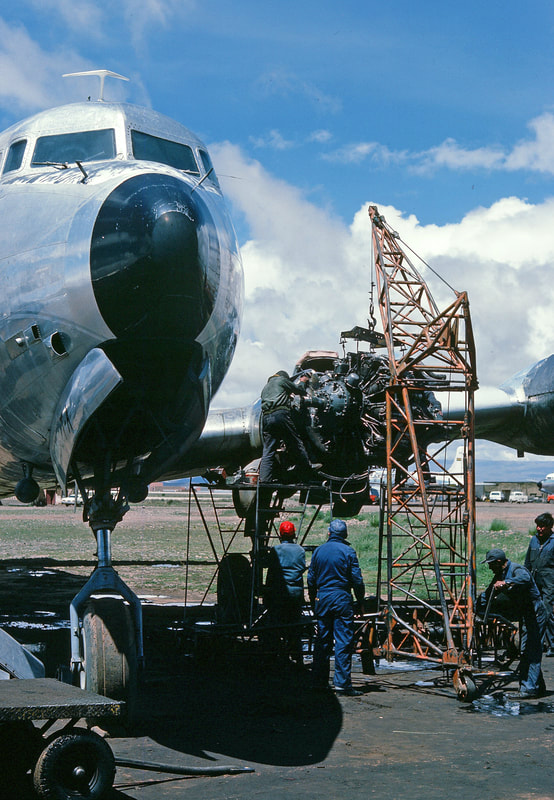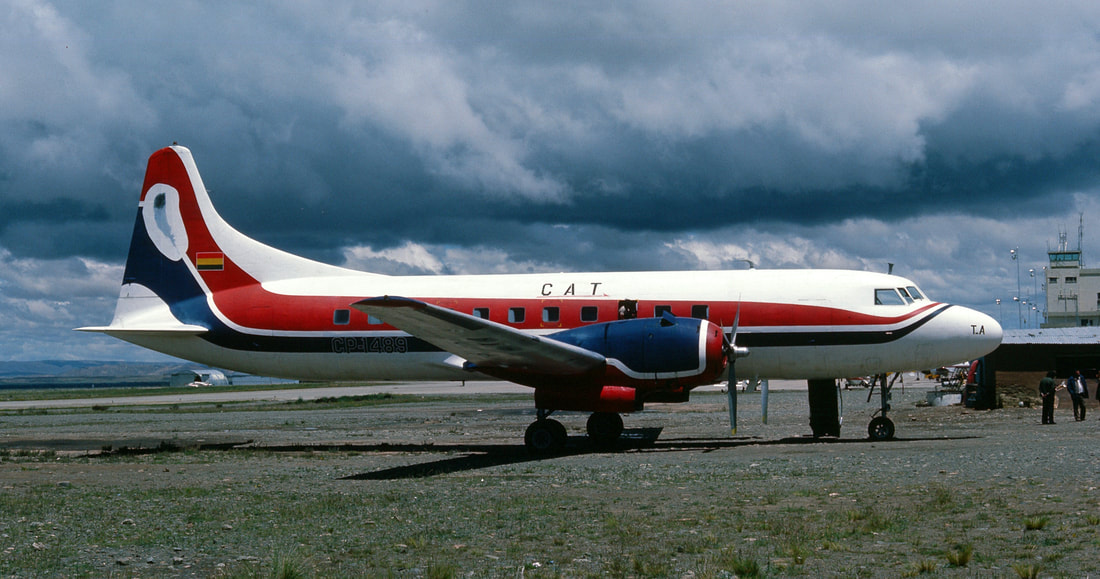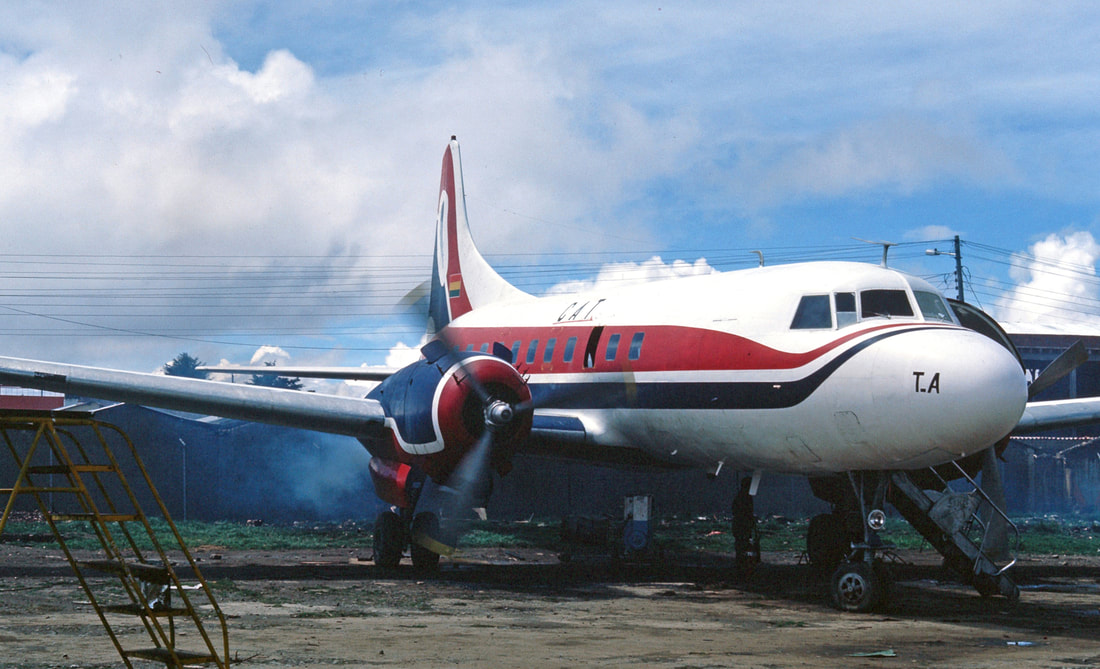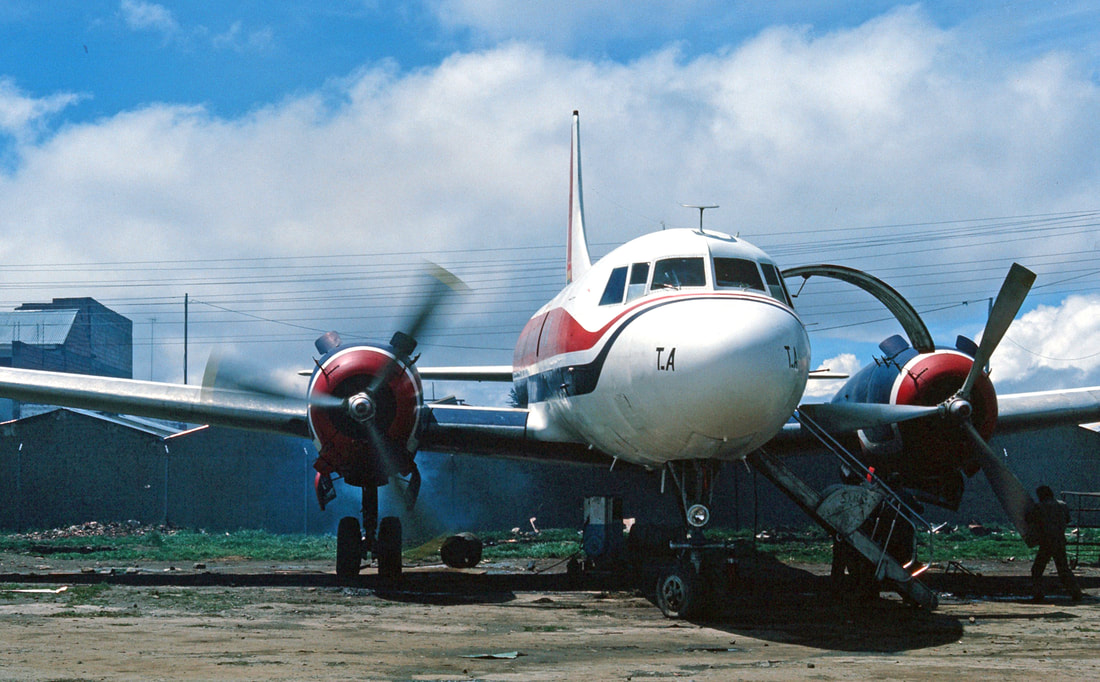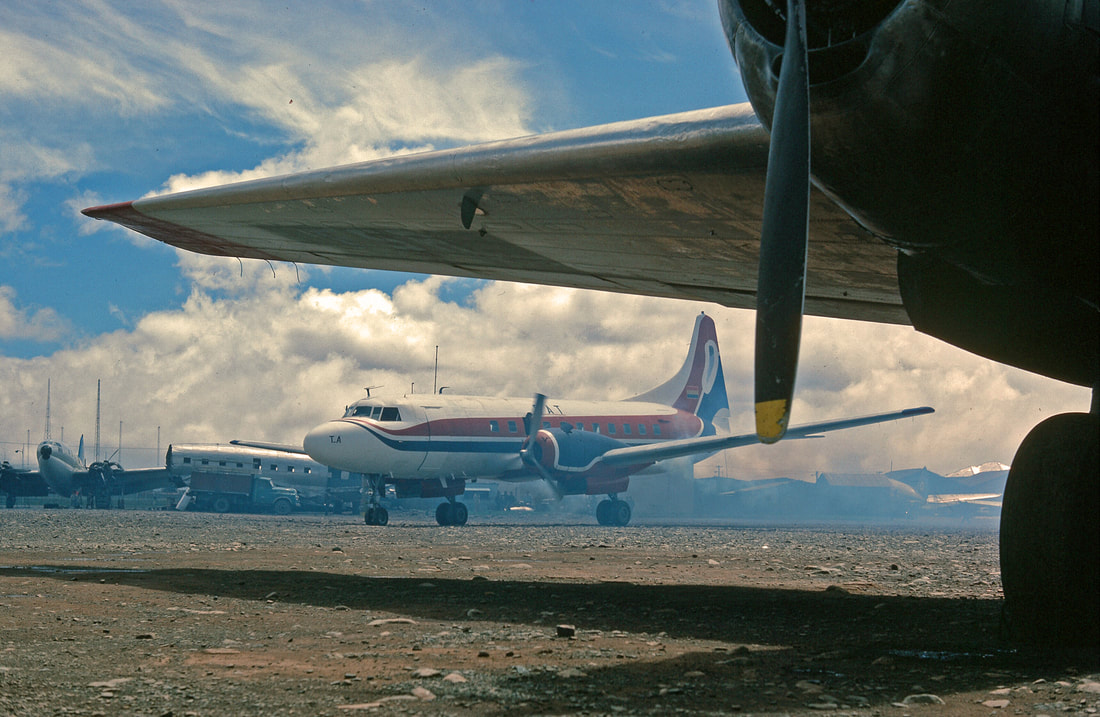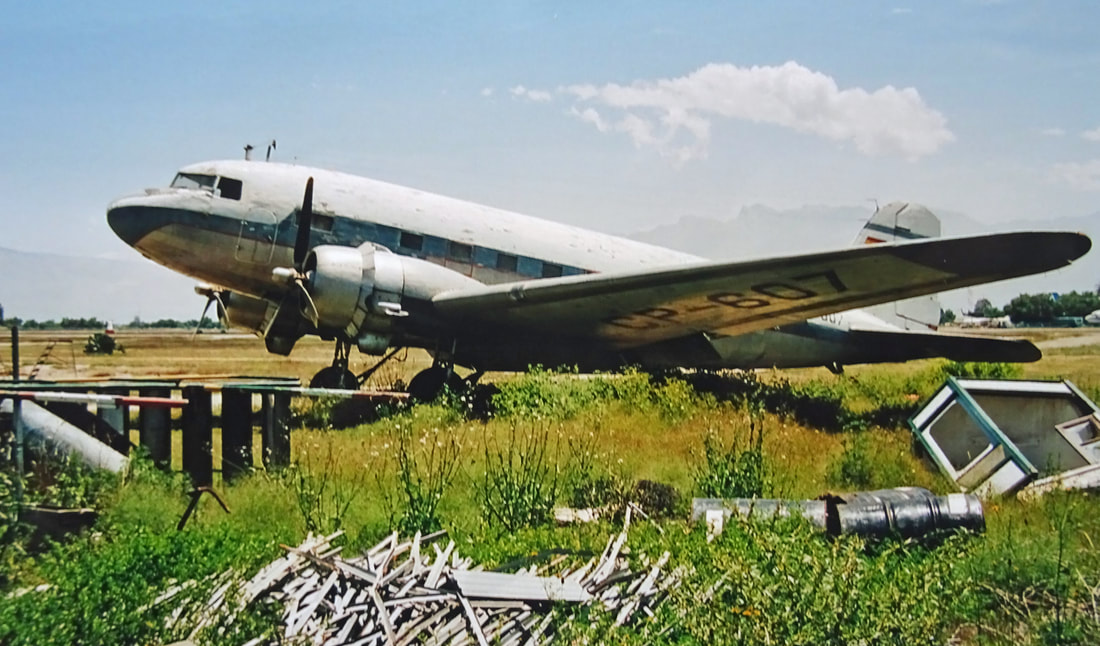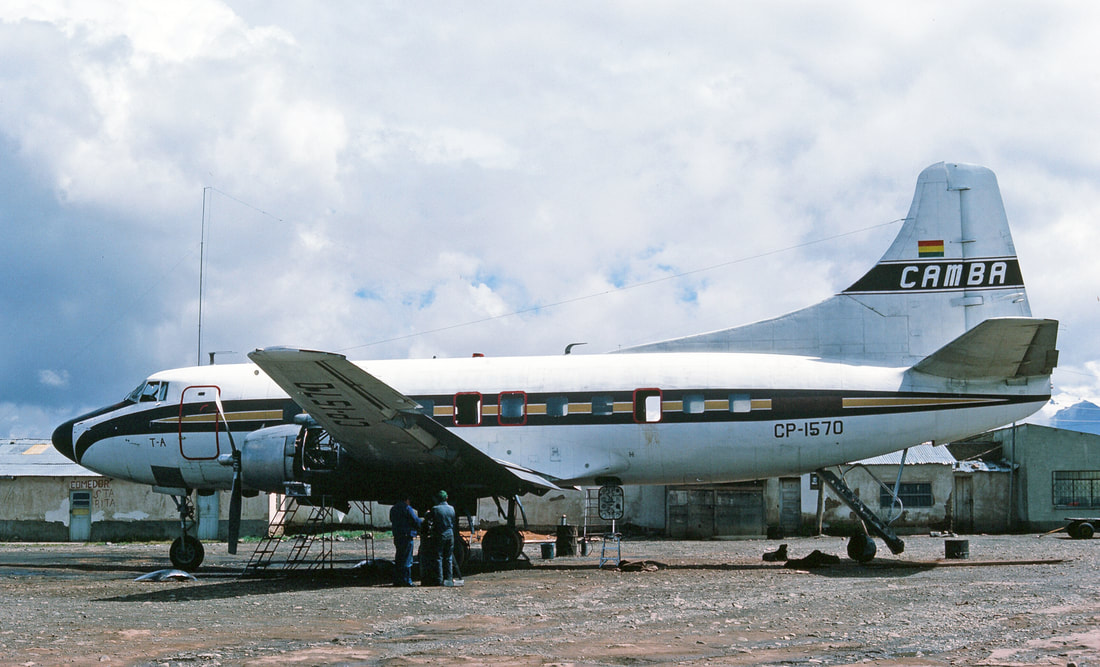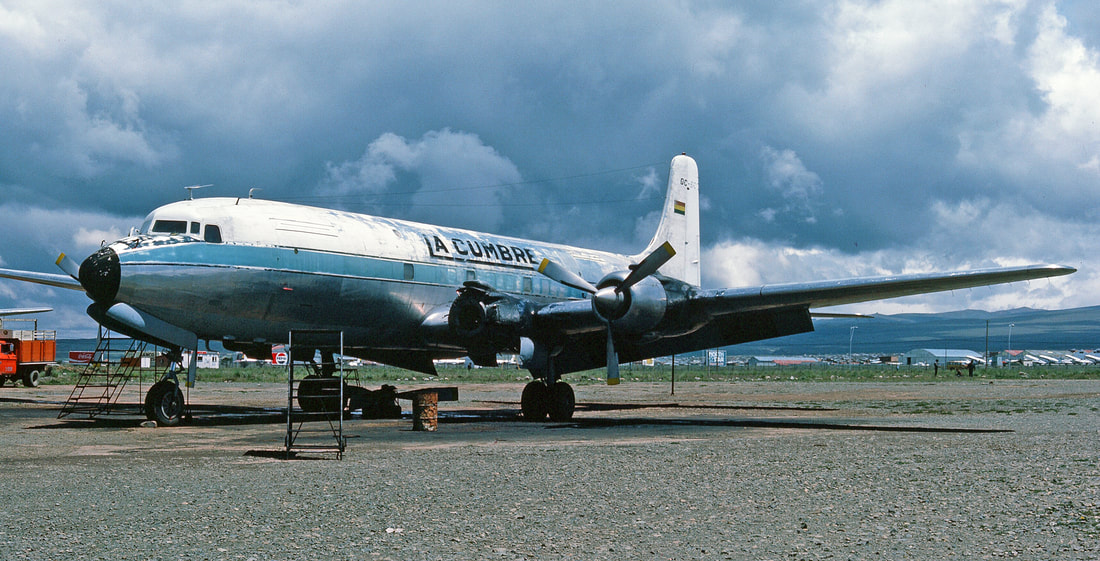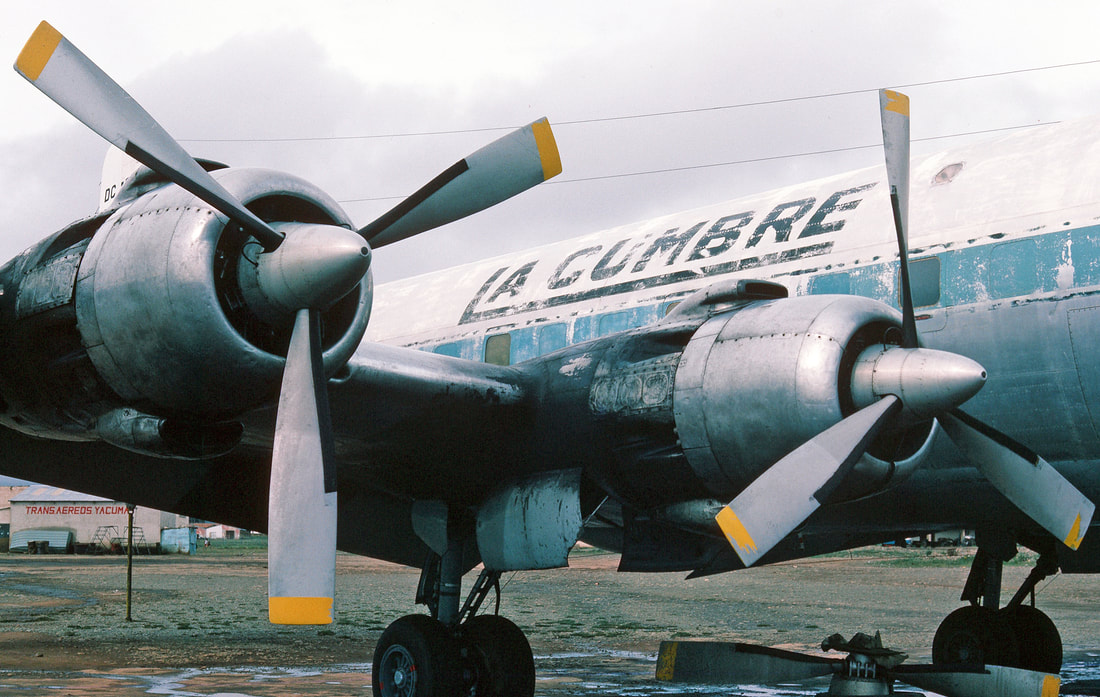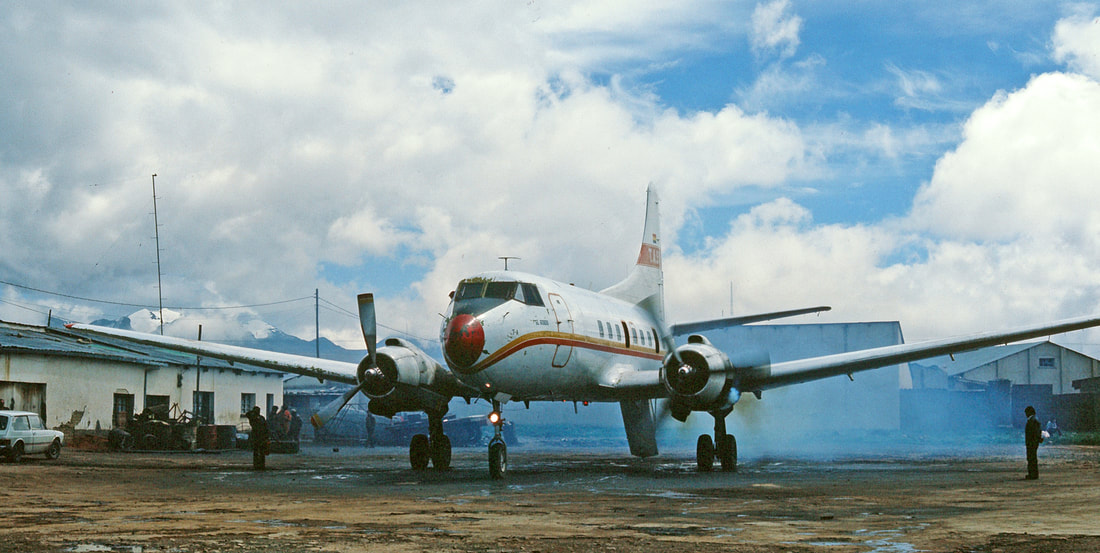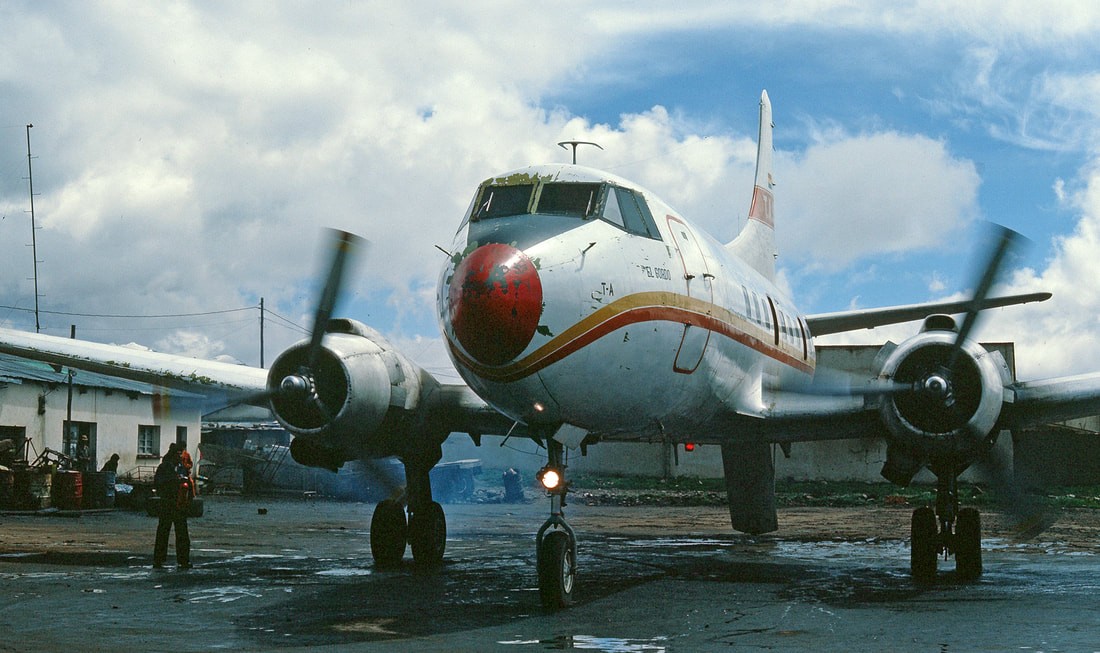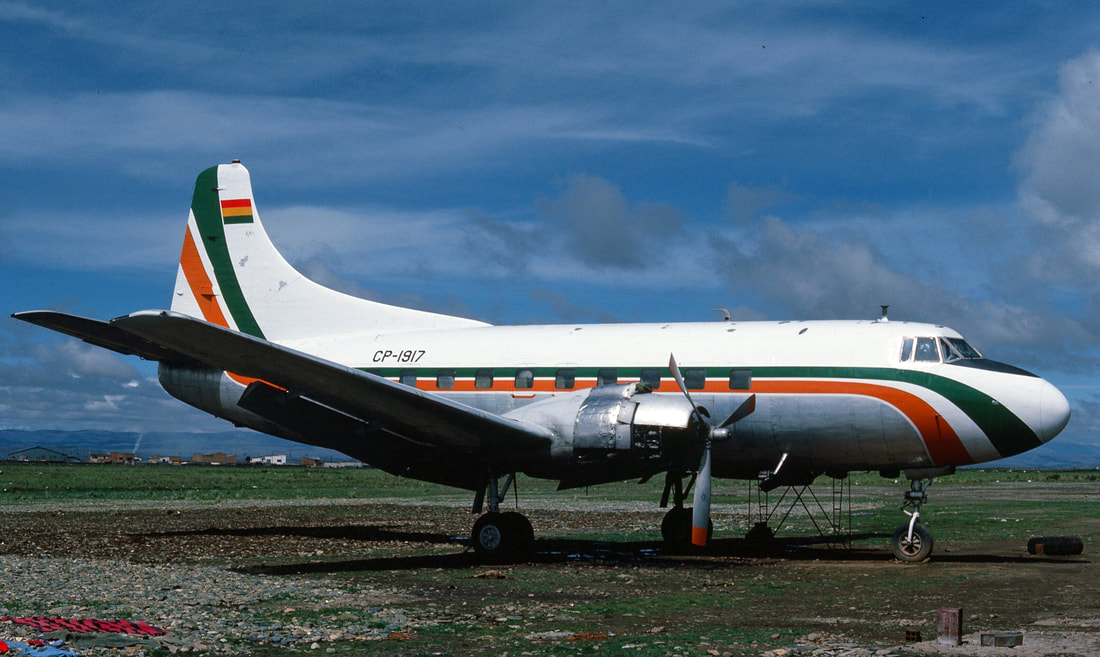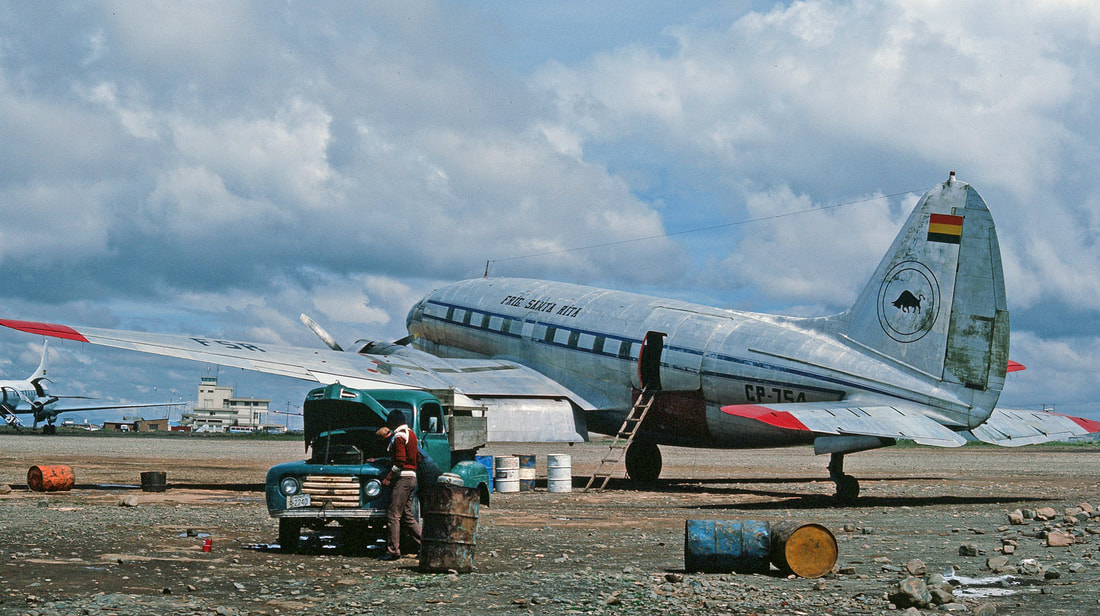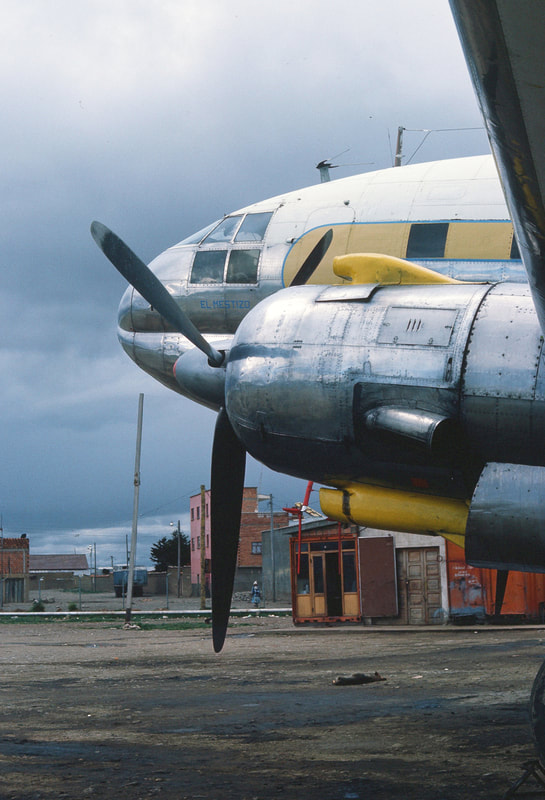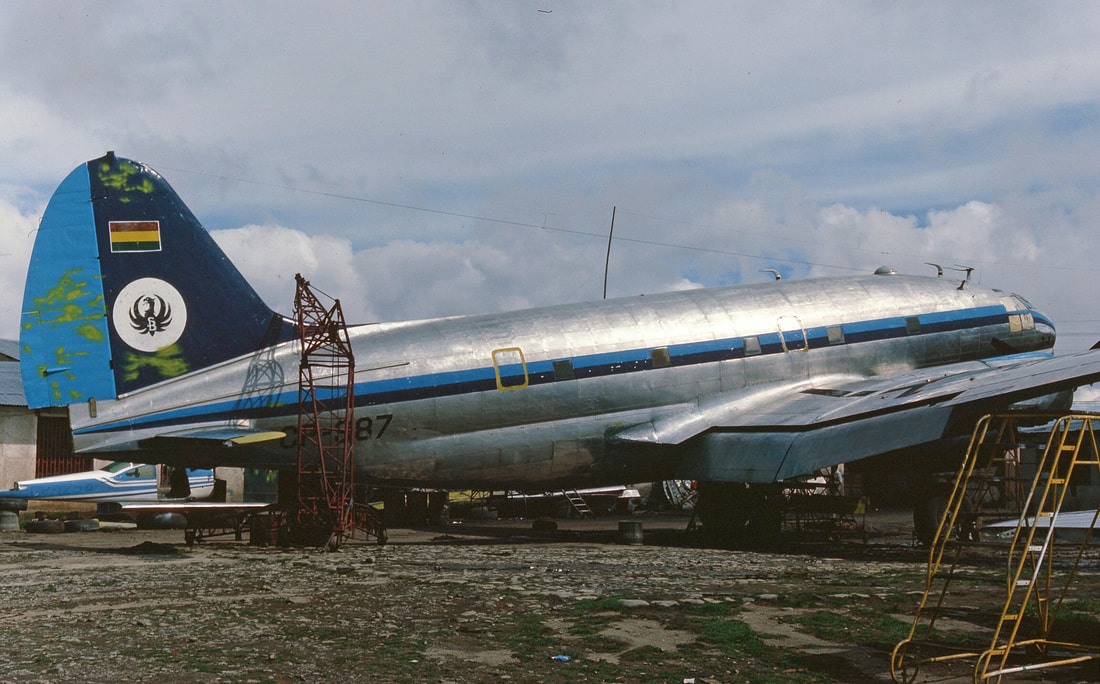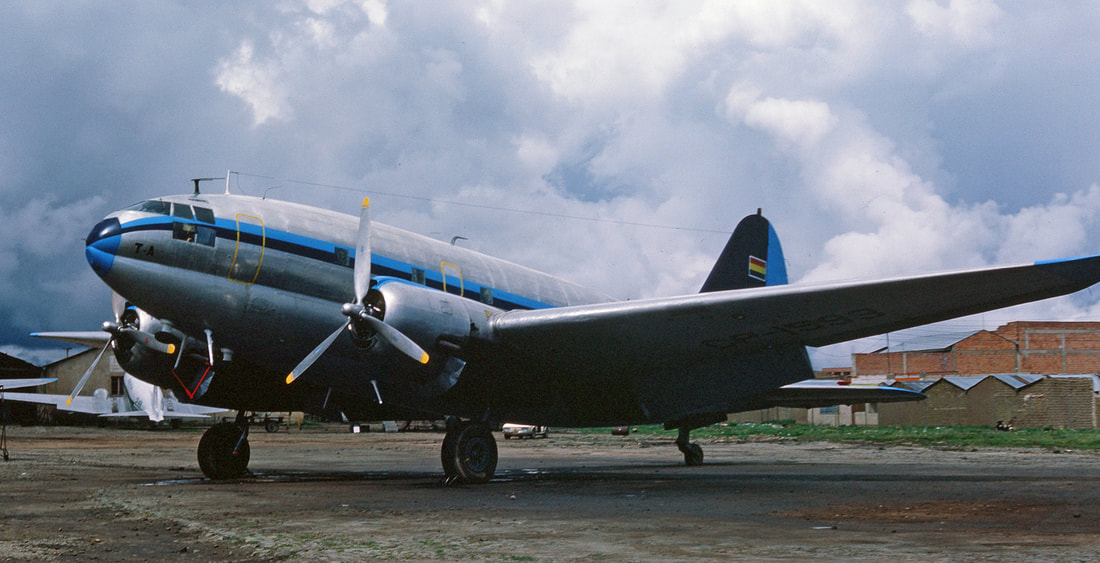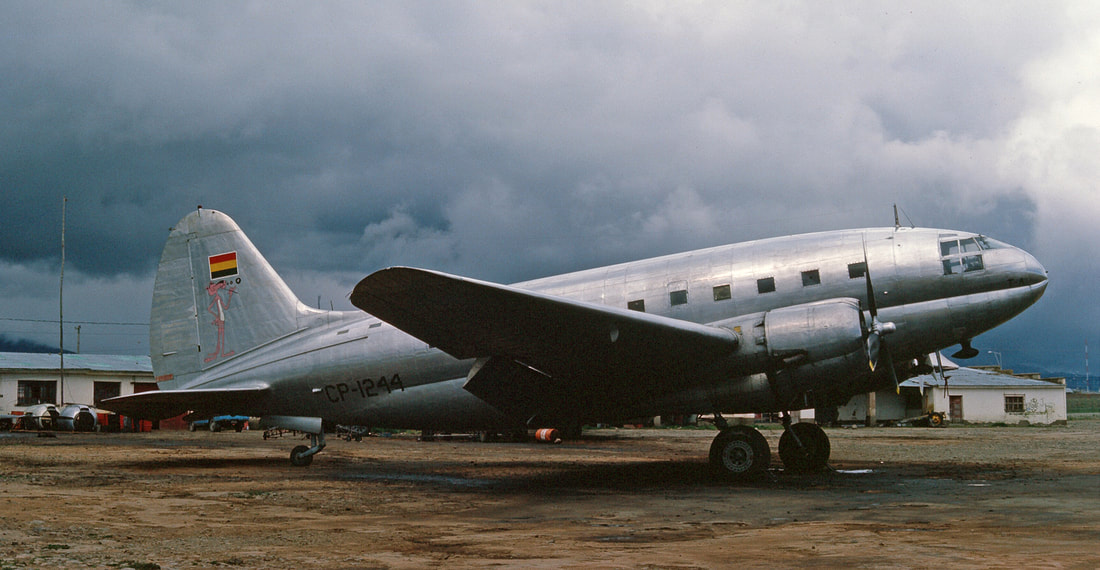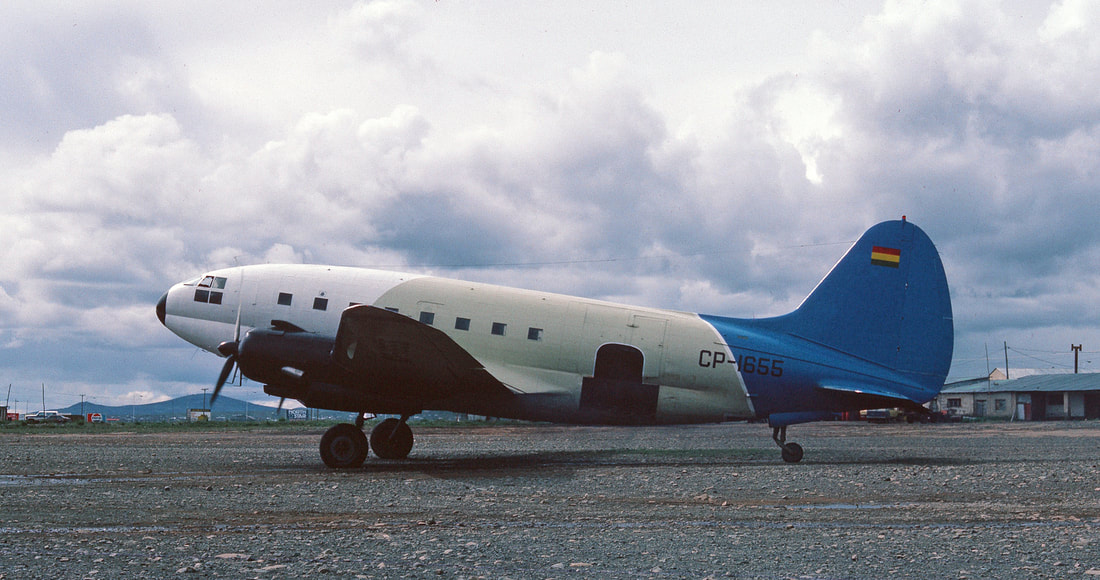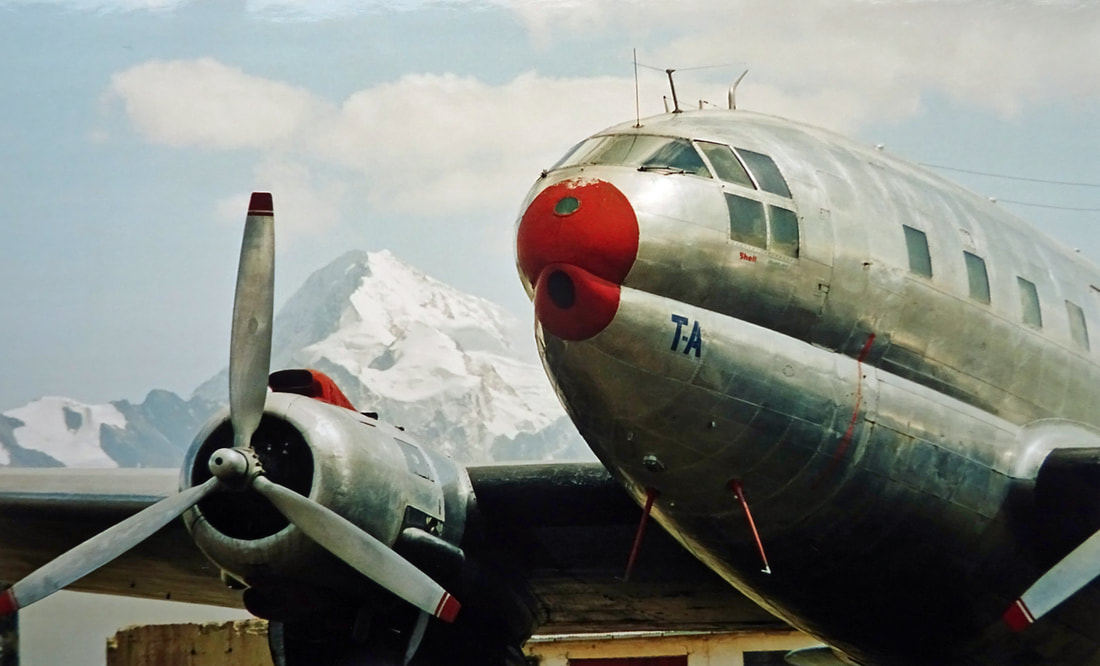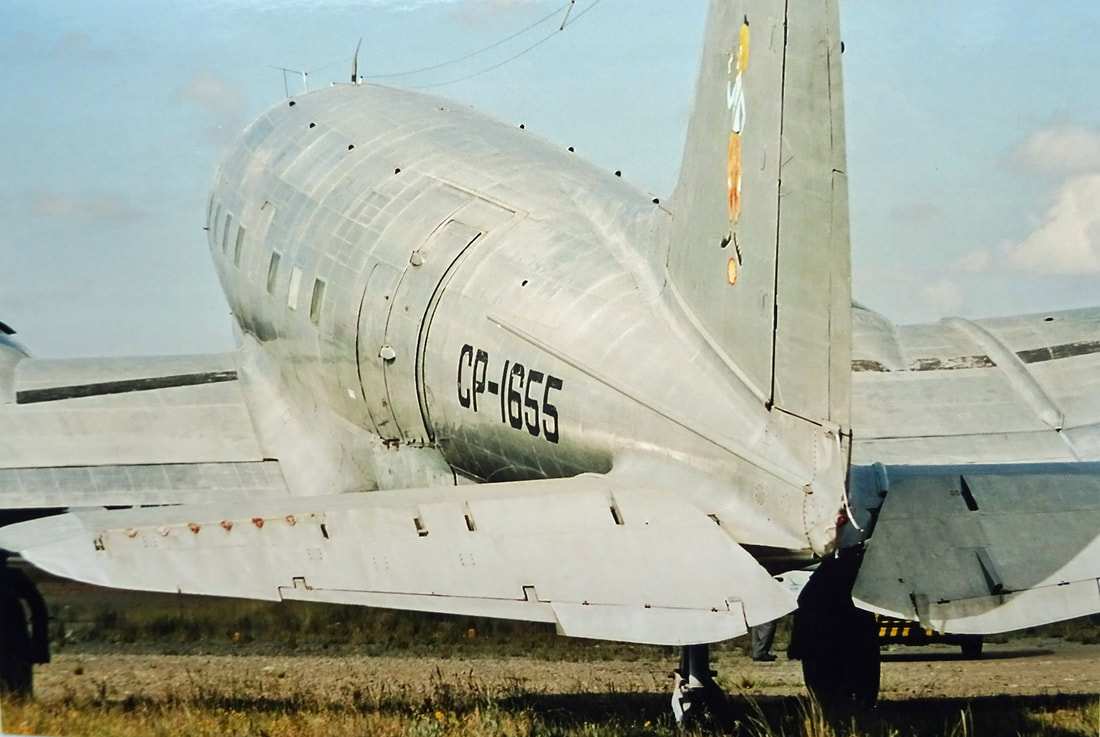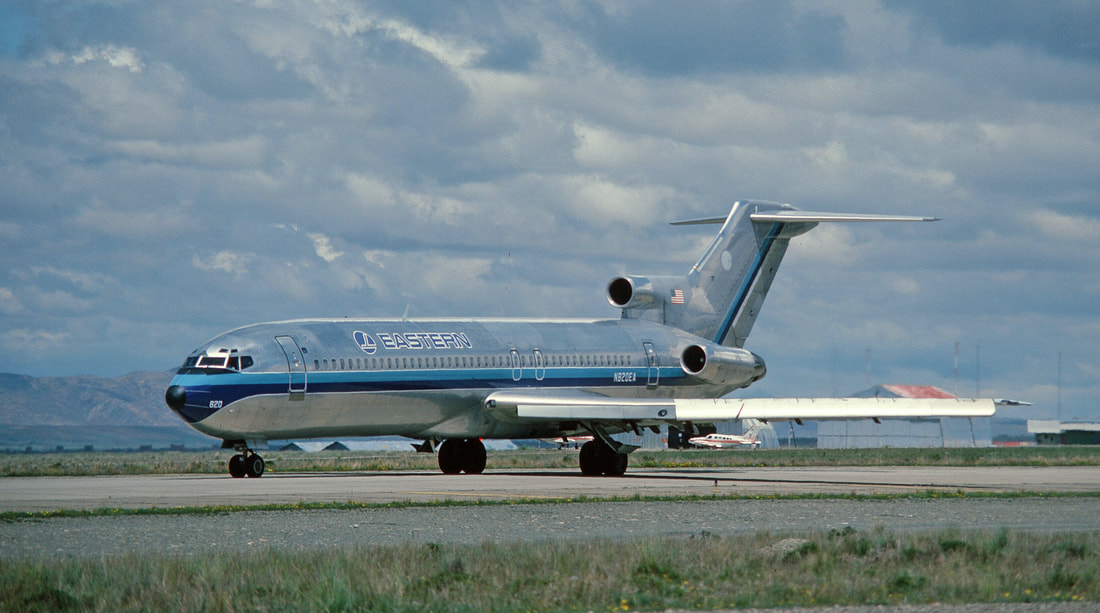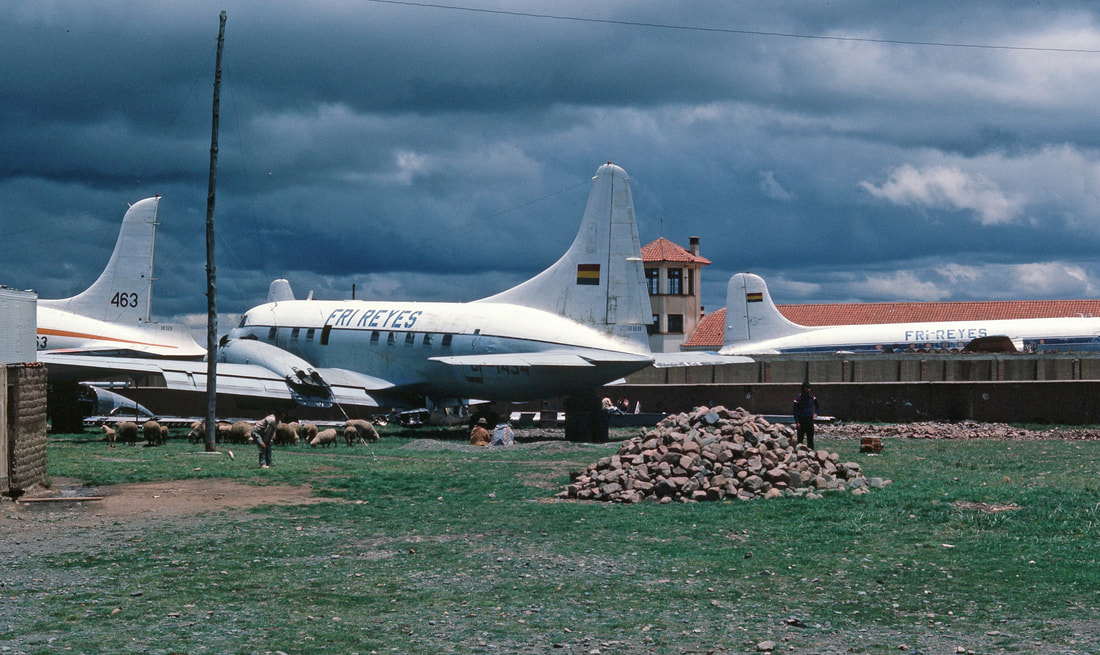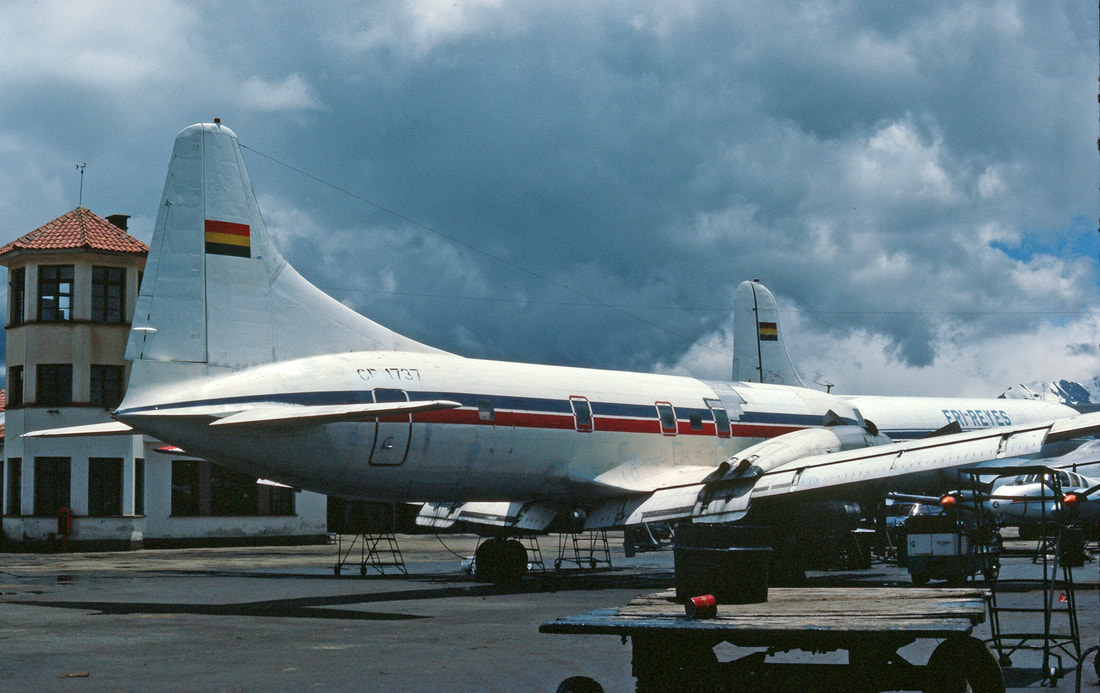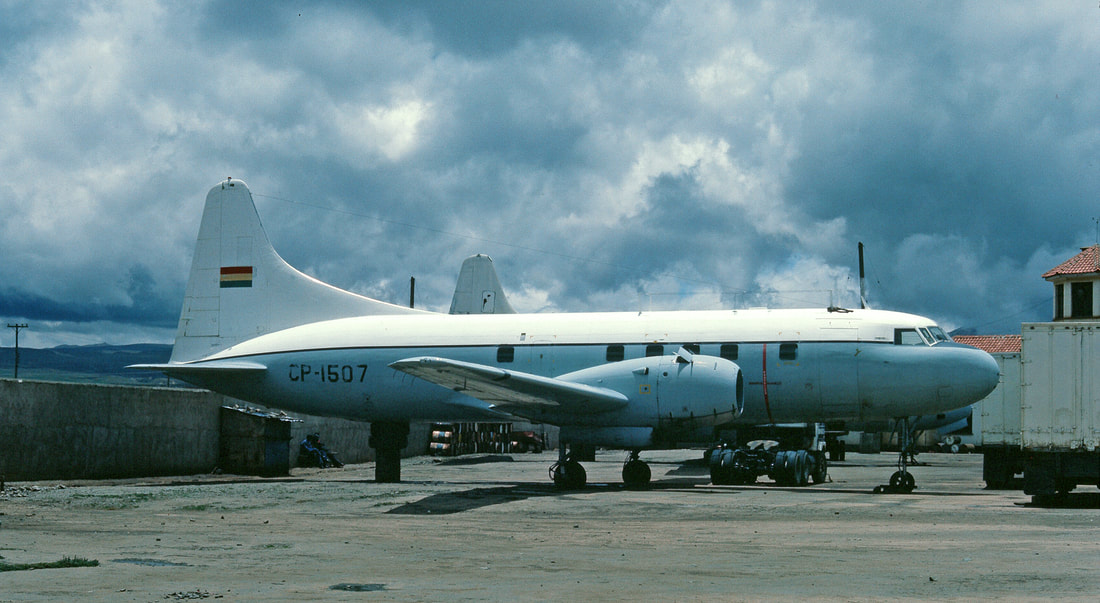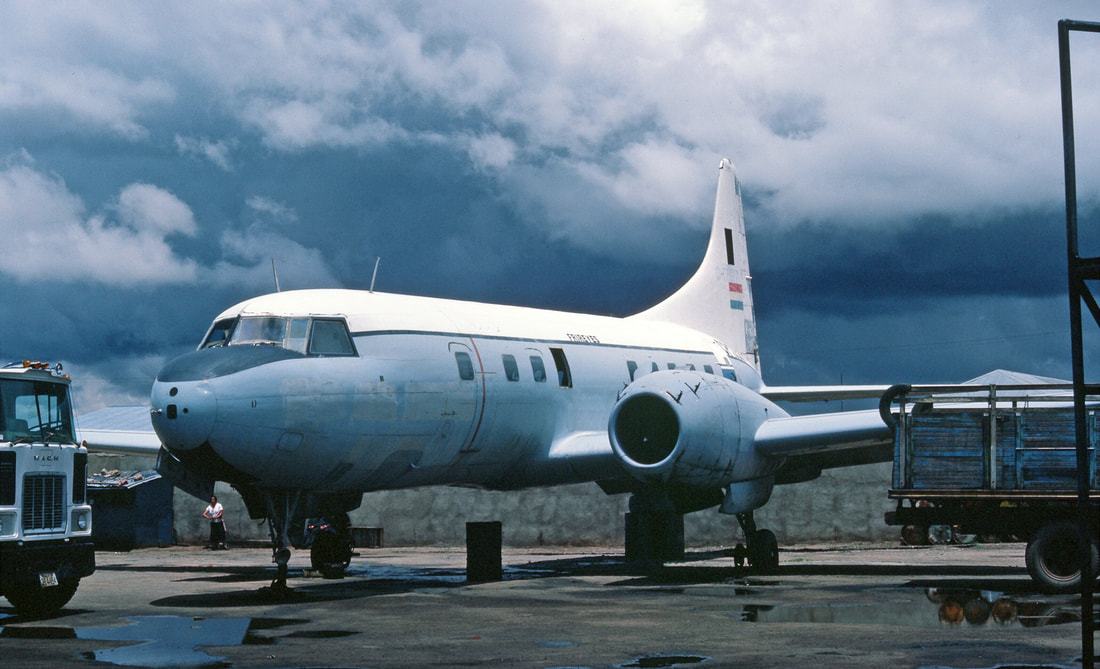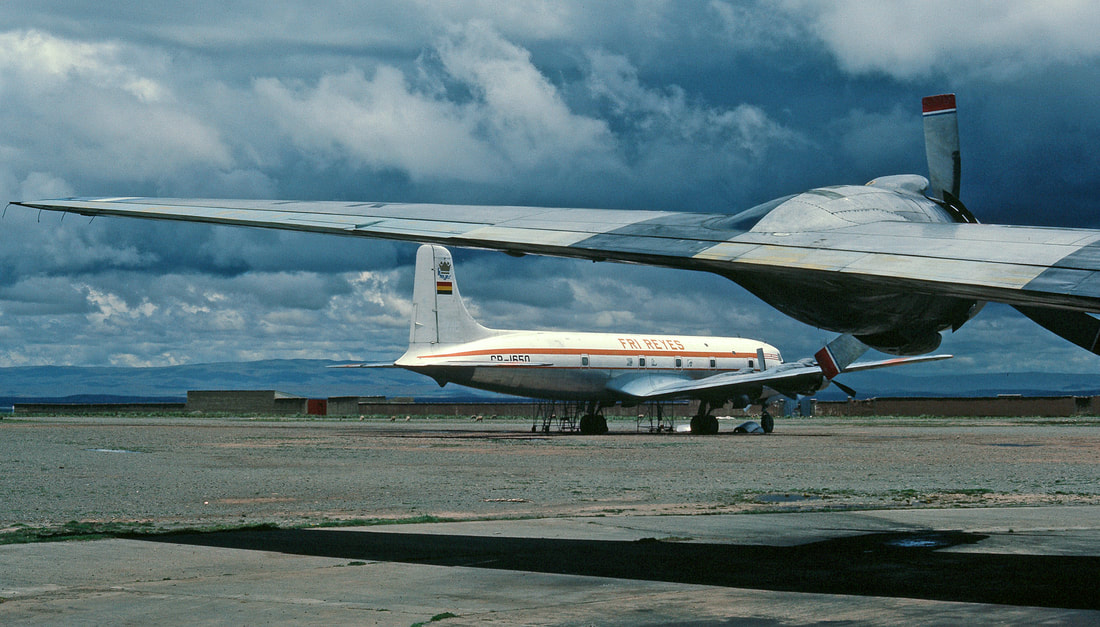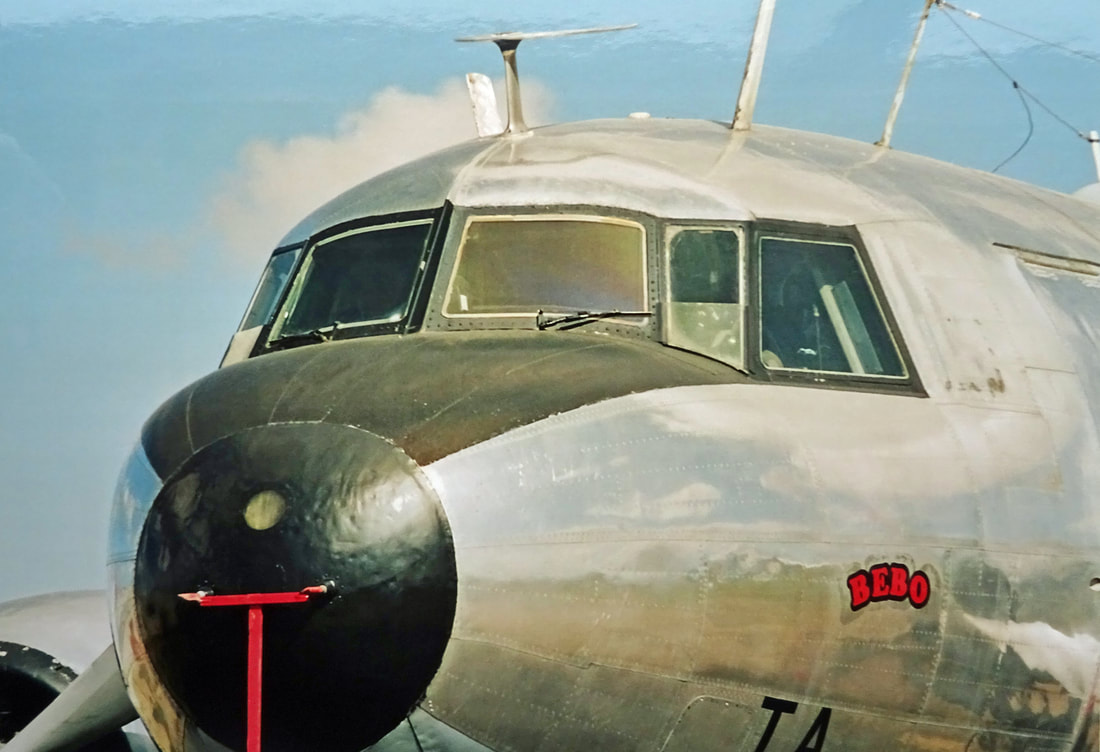La Paz - El Alto
Carniceros del aire
Feb. 1985
In the early 80's aircraft and airframes were scattered all over the old La Paz Airport premises, with a dozen of old 'hangars', nothing more than dilapidated small depots and low buildings with corrugated roof plating.
Douglas DC-6, CP-1654, warms her natural metal finish in the strong Bolivian sunshine.
This DC-6 rolled-off the Santa Monica production-line in 1947 and was delivered new to American Airlines as N90730. Twenty years later she was sold to aircraft broker Miami Aviation Corp. and passed through a succession lessees, before ending-up with ETA Airlines in January 1981.
CP-1654 still wears faded SAVCO titles from its days with Servicios Aereos Virgen de Copacabana.
The aircraft shows signs of fretting below the right hand door handle. Fretting occurs where two pieces of metal are rubbing together, leaving a black oily deposit. Lubrication on hinge points, either control surfaces or access hatches, can also produce fretting marks.
On March 8, 1993, during the takeoff roll from Santa Rosa de Yacuma, CP-1654, prior to V1 speed, the engine n°2 caught fire and exploded. The crew abandoned the takeoff maneuver and initiate an emergency braking procedure. Unable to stop within the remaining distance, the aircraft overran and came to rest, bursting into flames. All four occupants evacuated safely and the aircraft was destroyed by fire. The crew was flying to La Esperanza to pick up a load of meat.
|
The Douglas DC-6 was originally intended as a military transport near the end of World War II. It was reworked after the war to compete with the Lockheed Constellation on the long-range commercial transport market. More than 700 were built and some still fly today. The DC-6 was known as the C-118 Liftmaster in United States Air Force service and as the R6D in United States Navy service prior to 1962, after which all U.S. Navy variants were also designated as the C-118.
|
|
Engine replacements before the next adventure over the Andean peaks into cattle farms in the Bolivian llanos for the daily ‘carneo’ by these brave meat freighters.
The Pratt & Whitney R-2800 Double Wasp is an American twin-row, 18-cylinder, air-cooled radial aircraft engine with a displacement of 2,800 cu in (46 L), and is part of the long-lived Wasp family of engines.
The R-2800 saw widespread use in many important American aircraft during and after World War II. |
Convair C-131B, a Servicios Aereos Santa Ana aircraft, wears registration CP-1755 and is named ‘El Jefe’.
What a neat little air-stair!
CP-1755 provided yeoman service for Servicios Aereos Santa Ana and still is wearing her United States Air Force uniform.
CP-1755, a Convair C-131B Samaritan had been delivered in March, 1955 to the USAF. After her military career she was imported into Bolivia in April 1982 to become a meat hauler for Servicios Aereos Santa Ana. She was a good ship and hung on till the end, when she was scrapped in the late 80’s.
Yacuma, 1955 built Convair C-131B, CP-1676, looks to be in superb condition.
Click here to edit.
This Samaritan is a C-131B which was built in the Convair factory of San Diego with construction number 268. When her military career was over in 1981, her civilian life started in Bolivia where she worked for Yacuma (Yacuma is also the name of a province in the Beni, Bolivia). I believe, she was broken-up in the early 90’s.
CP-1489 awaiting her flight-crew.
CP-1489 makes an early morning engine start.
A typically smokey-start-up for a Convair R-2800.
I vivid remember standing in front of those Pratts starting-up on the El Alto ramp.
Carga Aéreo Transportada Convair CV-440, CP-1489, is still retaining her former Reamco Inc. colors.
With 2000 hp of tired iron turning on either side, CP-1489 is held against the brakes.
Morning departure to the Beni.
CP-1489 rumbles past.
Convair 440 CP-1489, which was manufactured in the first months of 1956 enjoyed a long and various career. She operated for Continental Airlines and, as executive aircraft, for various U.S. Corporations. In June 1981 she was exported to Bolivia and Cargo Aereo Transportada became her new and proud owner.
Veteran Convair CP-1489 trundles towards the take off point on La Paz extra long runway, in readiness for her flight to the Beni.
On Sunday, April 20, 1985, on departure from Santa Rosa airstrip the no. 2 engine had failed shortly after V2 speed. The aircraft crashed nose-down on climb out after losing control.
Mid-day sunshine glints off the polished aluminum fuselage of this wings clipped Curtiss.
This 1945 built Curtiss C-46 Commando did operate for the USAAF as 44-78605. When her military career was over in 1946, she enjoyed a long and various career. She operated inter alia for Civil Air Transport of Formosa, Flying Tiger Line, Zantop and Span East before being sold to Transportes Aereos Bolivar as CP-1319 in November 1976. She was owned by this operator for more than 20-years! In the following years she also did operate for CAMBA, NEBA and finally Sky Team Cargo.
|
The crew of CP-1319 departed Santa Cruz-Viru Viru Airport on April 21, 2012, on a cargo flight to Cobija airport. Shortly after takeoff from runway 16, the crew informed ATC they were returning but they did not give any details about their situation. On final approach, the aircraft adopted a high-nose attitude, climbed then stalled and crashed 200 meters short of runway, bursting into flames. A passenger was seriously injured and all three crew members were killed. The aircraft was totally destroyed by a post-crash fire. The cause of the accident was that the aircraft, while on short finals and cleared to land, made an unusual flight maneuver by climbing almost vertically until a wing stall and plunging violently against the terrain, bursting into flames within the security area of the runway.
|
Martin 4-0-4 without a lick of paint on its dull, grimy hide other than the registration, CP-1704.
The, in 1952 manufactured Glenn Martin 4-0-4, CP-1704, started her airline career in USA with Trans World Airlines (TWA) as N40437. Nine years later, in 1961, she was sold as an executive aircraft. In this role she served several U.S. based corporations. In 1981 she was acquired by Compania Aerea Nacional (CAN) of Bolivia who used her as meat hauler.
Cleared skin Martin. - CP-1704, stripped back to bear metal during restoration work at La Paz, Bolivia, in February 1985.
On Monday, August 1985, an engine failure on takeoff from La Paz – El Alto forced the crew to carry out an emergency landing back at La Paz. The aircraft struck a perimeter fence and was damaged beyond repair.
Convair 440, CP-1574, is seen here under restoration at the Panambra’s ‘maintenance base’ at El Alto in February 1985. She still wears her faded Mackey International Airlines paint scheme from its days as N9306.
Convair 440 CP-1574 was manufactured in 1957 and delivered new to Eastern Airlines in April that year. This Pratt & Whitney R-2800 powered propline served the Miami based airlines faithfully for 13 years. In March 1970 she was sold to an American aircraft broker. In 1973 her ownership changed again and the Convair became part of the Mackey International Airlines fleet, as N447JM. Seven years later she was exported to Bolivia, where eventually Panambra Ltda became her owner. After Panambra she flew for Transportes Aereos America and Transportes Aereos Arauco. In the late 90’s she ended her duties and was broken-up at La Paz.
|
If an airplane is stored outside, it will be subject to wind, rain, hail and whatever else the local climate can throw at it. Why do your house windows need cleaning? Because rain deposits sand and dust on them. An airplane stored outside will be subject to streaking down the paintwork from dust and dirt deposits unless washed regularly. Damage to the fuselage side of multi-engine airplanes is likely due to ice breaking from propeller blades when de-icing equipment is in use. Dented skin and chipped paintwork will be evident on the fuselage in the plane of the propeller disc.
|
CP-1574 gets some body work done.
Maintenance is carried out in the open as a matter of routine – hangarage was a luxury most Bolivian operators could not or didn’t need.
CP-607 was delivered to the USAAF as 42-92736. Re-registered briefly as NC19364 to Panagra before being transferred in August 1945 to the Bolivian Air Force as CB-34. In June 1954 she went to the civilian market as CP-607, where she flew for Lloyd Aereo Boliviano. In the mid ’80 she was bought by Transportes Aereos Tadeo, and as such photographed. During the 90’s she worked a meat-hauler with Frigorifico Santa Rita, Transportes Aereos Virgen del Carmen, among others.
Transportes Aereos Tadeo (T.A.T.) C-47A CP-607 in front of a typical El Alto shed with engine nacelles and scaffolds.
The port engine of the C-47 comes under scrutiny.
Twenty years later. Same aircraft, same registration, other airfield, looking neglected.
Cochabamba, March 2005.
Cochabamba, March 2005.
Commercializadora Aérea Mixta Bolivana Martin 4-0-4, CP-1570.
This Martin 4-0-4 was one of a batch of 41 aircraft for Trans World Airlines. She first flew on 11 July 1952, and entered service with TWA as "Skyliner Detroit" under fleetnumber 433 on July 25, 1952. In November 1959, the N40432 was sold to Pacific Air Lines that operated a total of fourteen secondhand Martin 4-0-4's over the years. Pacific Air Lines operated Martin 4-0-4 N40432 until August 1968. After several private Traveller Club's like Fiesta Air, Stardusters, Lake Los Angeles the airliner found her way to Bolivia via Sky Commerce Inc., from Miami. Registration N40432 was cancelled as exported to Bolivia on August 04, 1980. In Bolivia the Martin 4-0-4 was registered CP-1570 with CAMBA (Comercializadora Aérea Mixta Boliviana Ltda) and operated as cargo/meat hauler to the Beni in the Bolivia lowlands.
Flaps fully down, emergency windows open, CP-1570 of CAMBA undergoes an outdoor check in a corner of La Paz, El Alto in February 1985.
On June 16, 1987, during a test flight from Paraparau airstrip One of the Pratt & Whitney R-2800 engines backfired. A belly landing was carried out and the Martin was damaged beyond repair.
CAMBA's impeccable maintenance standards.
This battered looking DC-6C retains traces of its VASP livery a full eight years after being purchased by La Cumbre. Up to this date, CP-1282, still sit inactive at El Alto.
Photo above shows again the DC-6C CP-1282, with engines nr 1, 3 and 4 still mounted.
Douglas DC-6C, CP-1282, once a proud propliner that flew for Panair do Brasil all over the World. She arrived in Bolivia in 1977, an era in which many four engine propliners were making room for the Jetliners.
Their career ended here in Bolivia.
CP-1283 is a former VASP ship. During her career with Viação Aérea São Paulo S/A, she was registrated PP-LFA.
CP-1283 at the end of her career.
Twenty years later. Same aircraft, same registration, same airfield, same uniform but looking a bit scruffy.
La Paz, March 2005.
La Paz, March 2005.
Even with all four engines removed CP-1283 still manages to look classy.
Time is running out for the last La Paz survivors.
She was withdrawn from use and stored at La Paz a long time ago, but still retains tell-tale signs of its last airline identity in the this photograph, taken in March 2005.
Transporte Aereos Samuel Selum, Martin 4-0-4 CP-1738.
Pictured in February 1985, this Martin 4-0-4 was built for Eastern Airlines as N446A and first flew in December 1951. She was operated by Eastern until November 1962. After that year she changed hands many times. Finally she was exported to Bolivia in 1982 and registered as CP-1738 to Transporte Aereos Samuel Selum (TASS). Some years after my visit, she was sold again and Air Beni became her proud owner.
The absence of asphalt or concrete is striking, but the soil is so soaked with oil that you will hardly notice this.
Meticulous maintenance kept them flying! R-2800 propeller control unit maintenance, on the TASS company ramp.
Ice, hail and rain have battered away the paint from the radome and the fuselage skin above the cockpit windows, making this workhorse look a little the worse for wear.
You can almost hear the two Pratt & Whitney R-2800-CB16 18-cylinder two-row air-cooled radial engines roar, as "El Gordo" is about to leave her parking spot.
Two veterans move away from her parking spots at La Paz, one afternoon in February 1985.
Transporte Aereos Samuel Selum, Martin 4-0-4, CP-1938, departing its base in February 1985, dutifully watched by the company’s entire staff.
Five minutes later the old gal just rumbled over El Alto on her way to the Beni.
On Saturday, April 7, 1990, the Martin suffered a runway excursion accident at Camiare Airstrip in Bolivia, causing the starboard undercarriage to fail. The airplane had departed Camiare Airstrip on a cargo flight to La Paz when, about seven minutes after takeoff, the no. 2 engine began to 'backfire' and developed a 'strong vibration'. Returning to Camiare, the pilot carried out a down-wind landing, as he was not able to fly a circuit due to problems maintaining altitude. The Martin was damaged beyond repair.
Transporte Aereos Samuel Selum, Martin 4-0-4, CP-1917, looks pretty neat.
|
An all too common sight at La Paz. This Martin 4-0-4 stands idle at La Paz, El Alto airport with an engine casing open for maintenance.
Transporte Aereos Samuel Selum, ex Eastern Airlines Martin 4-0-4, CP-1917, is seen here parked at La Paz El Alto airport. TASS was founded in 1984 and operated two Maring 404's as freighters on domestic meat hauling flights. CP-1917 was destroyed after take off from La Paz during April 1990.
|
Frigorifico Santa Rita Curtiss C-46 Commando, CP-754, is seen here parked with some storm clouds brewing in the background.
CP-754 aluminum looks shiny.
|
Cnl. Don. Jorge Nava Herrera QDDG.
|
After retirement from the military, CP-754, which was built in 1945 for service with the USAAF, was sold on the civilian market. During the 50’s she saw service with Riddle Airlines from Miami and in the early 60’s she was exported to Bolivia. In 1976 she became part of the Frigorifico Santa Rita fleet.
On March 2, 1992, the aircraft did not gain enough speed on take-off from Estancia El Trompillo because of a wet runway. The plane cleared a fence, then struck the ground left wing-first and crashed.
|
In Bolivia, they had a year-round job, in a big country with a poor infrastructure and so many people to cater in La Paz city.
In the late 1990’s, the infrastructure of Bolivian roads improved and refrigerated trucks came on the scene. That was the death-knell for the vintage fleet of Flying Dinosaurs.
The mighty powerhouses of the Curtiss Commando.
|
CP-1848 original dark blue paint scheme was haggard but still generally intact, chipped off in a few places, and mostly vacant on each side of the nose where ice flung off by the propellers had pounded it off.
Curtiss Commando CP-1848, which was manufactured in 1944 enjoyed a long and various career. After the war she was bought by well-known C-46 Parts Inc. from Miami. For re-sale. In the following years she operated respectively for Transportes Aereos Squellas and Transportes Aeros Suravia, both in Chile. In 1981 she was acquired by Frigorifico Santa Rita.
|
DC-3 maintenance, La Paz, El Alto airport, February 1985.
CP-529 was constructed as a DC-3A in early ’42. She was ordered by Northwest Airlines, but, due to the war, she was taken on strength by the USAAF. Just after the war, she was exported to Bolivia and became a Lloyd Aero Boliviano flagship. In 1977 she became a member of the Frigorifico Santa Rita fleet.
On Saturday, February, 1992, Frigorifico Santa Rita Douglas DC-3A, CP-529, had an accident while one of her engines were tested at the Carolita ranch, Bolivia. A fire erupted during the engine test and one of the wings caught fire, destroying the whole plane.
At the turn of the century there was no more market for these WWII aircraft in South America, so the only chance to survive was that a museum would pick her up one day.
Resplendent in its natural metal finish, the broad-shouldered Commando enjoys a quiet Sunday afternoon at El Alto, in February 1985.
Nose riding high, Transportes Aéreos El Dorado, Curtiss Commando C-46, CP-1617, named ‘El Mestizo’, is seen here patched-up, with paint-faded fuselage, with antiquated oil-dripping engines and its obtuse way of resting on a tailwheel.
|
This rough looking, but good performing Curtiss Commando went to the USAAF as a C-46A. After the war she served among others for Varig and Air Haiti. The latter sold the Curtiss in December 1980 to Eldorado. In the early ‘90s, Universal became her new and last owner.
On May 14, 1991, the Curtiss Commando carried out a wheels-up landing following failure of the no. 2 engine while climbing through 5000 feet from Estancia la Esperanza airstrip with destination La Paz.
|
Transportes Aéreos San Jorge C-47, CP-1960, receives mechanical attention in the open.
|
Delivered initially to the USAF in 1942, it later saw service with the Brazilian Air Force. After her military career she entered the civil market and was operated by Rico Taxi Aereo for a long time. In November 1984 she was sold to Transportes Aéreos San Jorge.
On November 2, 1992, the number two engine had been changed and a test flight was made from the San Juan Ranch airstrip. Shortly after takeoff the no1 engine backfired and smoke entered the cockpit. The engine was shut down and propeller feathered. A forced landing was made in swampy ground short of the runway.
|
Sabeni Ltda Curtiss Commando C-46, CP-987, shows her age and must have quite a life on the clock.
The history of CP-987 reads as follows; - This airframe left the factory at Buffolo, NY in 1944 and was, like hundereds of other Curtiss Commando’s, delivered to USAAF. After her military service she worked for companies such as; C-46 Parts Inc., Transportes Aereos Illimani, Frigorificos Movima, Sabeni Ltda, Aerovias Las Minas, Aero Beni and finally from 1994 for Air Beni. She is still stored at La Paz in reasonable condition.
Twenty years later. Same aircraft, same registration, same airfield, other uniform but looking a bit weather-beaten.
La Paz, March 2005.
La Paz, March 2005.
Decidedly static, Curtiss C-46 Commando, CP-987, at La Paz, in March 2005, minus her powerful R-2800's engines.
Well worn, Servicio Aéreo Beni (SABENI) Curtiss C-46 Commando CP-1593, exudes rugged dependability.
Originally delivered to the USAAF in December 1944 as 44-77540, the Curtiss passed through a succession of owners, including Aaxico Sales, C-46 Parts Inc. and Chilean Aerolineas Flecha Austral Airlines, before ending up with Sabeni Ltda in 1980.
C-46, CP-1593, still manages to look majestic despite being parked amid the aeronautical trash at El Alto, in February 1985.
On October 11, 1985, the Curtiss crashed in mountainous area while flying a cargo of meat to La Paz.
Rudderless Aerolineas La Paz Douglas C-47A, CP-1418.
This frame flew for the USAAF during the D-Day invasion with 82nd Airborne division. After the war she was sold the Fuerza Aerea Argentina, who in their turn, donated the Skytrain to the Fuerza Aerea Boliviana in 1969. Several years later she was transferred to the Transportes Aereos Militares as TAM-31.
On January 17, 1989, the Douglas went missing during a flight from La Paz to Apolo, Bolivia.
A supposedly anonymous Curtiss Commando is seen here parked on El Alto, on a wet morning in February 1985, but the registration CP-1244 identifies it as one of the Empresa Transporte Aereos fleet.
This natural metal C-46, has changed hands many times. She rolled of the Buffolo, N.Y. production-line in 1945 and was operated by the USAAF in India. After the war she was sold and passed through a succession of owners, including TABA and VASP, both in Brasil, before ending up with Empresa Transportes Aereos (ETA) in 1979.
On January 18, 1988, the Curtiss struck Colorado Mountain in bad weather, 100 km northwest of La Paz during a flight to an airport in the Beni Department.
CP-1655 still wear the remnants of Transported Aereos Da Bacia Amazonica (TABA) distinctive color scheme.
This airframe left the factory in February 1945 for delivery to the USAAF in India. When her military career was over, her civilian life started and the next couple of years she changed hands quite often. She worked for operators in the USA, Colombia, Sweden and Brasil. In 1983 Belem, Brasil based Transported Aereos Da Bacia Amazonica (TABA) sold the Curtiss to Bolivian meat hauler Universal Ltda who retained the TABA white/beige/blue livery and registrated her CP-1655.
Vivid images from La Paz – El Alto conjure up an atmosphere permeated with the smell of Av-gas fuel and the roar Pratt & Whitney R-2800’s.
Numerous years of oil-dripping big radial piston engines have left their mark of CP-1655 parking spot.
CP-1655 post-war career was based on flying to and from slaughter houses.
Kicking-up some mud, CP-1655 taxies out for take-off.
Twenty years later. Same aircraft, same registration, same airfield, other uniform but looking a bit tired.
La Paz, March 2005.
La Paz, March 2005.
This Curtiss Commando is a longtime resident at La Paz - El Alto Airport.
Their carcasses were being used to supply spares for the survivors and now await the cutter’s torch.
With clipped wings her service life seems over.
I saw this well cannibalized Curtiss next to the taxiway, with the nose up and its engine firewalls reflecting the sun.
On February 10, 1981, Transportes Aeréos Universal Ltda Curtiss Commando, CP-1588, was reportedly damaged beyond repair at the Caravani airstrip. The hulk was moved to La Paz. The cannibalizing of her kept many others airborne for decades. As all types were since long out of production, this was a self-supplying system that worked well.
I shot this 727-100 of Lloyd Aereo Boliviano in February 1985 at La Paz - El Alto.
Lloyd Aereo Boliviano Boeing 727-178 CP-1223 taxies out for runway 28.
By December 1999, CP-1223, was with 78.565 landings the highest cycle 727!
The 727 has a stunning shape, ...its kind of perfection in civil aircraft design.
After spending six years of its lifetime in the Caribbean, operating for British West Indian Airlines, this Boeing 737-78 was sold to Braniff International in 1971 as N306BN. After only four year of service with the Dallas/Forth Worth based carrier she was sold, in March 1975, to Lloyd Aereo Boliviano as CP-1773. I spotted her again in 2005 at the company’s Cochabamba headquarters, where she was in storage.
Twenty years later. Same aircraft, same registration, other airfield and a revised uniform.
Cochabamba, March 2005.
Cochabamba, March 2005.
A shining Eastern 727-200 at La Paz, February 1985.
The aircraft pictured, N820EA, was delivered to Eastern Airlines in April 1982. After 10 year of faithful service with the Miami based carrier, she was sold in March 1992 to Norhtwest Airlines from Minneapolis, Minnesota. Twelfe years later she was aquired by Champin Air for sport charter work. In 2008 she was parted-out but fortunately her front section is presently used as the Air Force One SAM27000 replica in the Presidential Experience Center in Denver, Colorado.
Fri Reyes Convair T29-D CP-1331 trundles out to join the take-off queue for runway 28.
Mind; - The very bottom of both engine cowls are blackened with grime, and farther back, the landing gear doors are streaked and smeared with a mixture of dirty exhaust soot and oil.
CP-1331 was delivered to the USAF as a Convair 240 (T-29) in 1955 and was struck off charge in the mid 70’s. In August 1977 she was acquired by Fri Reyes. After many years of faithful service, as a meat hauler, she was finally stored and chopped-up in the early 90’s.
CP-1331 is seen here heading purposefully towards the runway threshold.
Bolivian aviation history stands in background on this photo.
The climate here on the high Andes is good for aluminum to survive for long.
Fri Reyes bought this aircraft in 1978 from the USAF and operated it for several years before withdrawing it from use and storing it at La Paz.
Although the colors scream Faucett Peru, OB-R-827 was actually owned by Fri Reyes from La Paz, Bolivia.
Mind; - She was 'Equipado con radar'!
Mind; - She was 'Equipado con radar'!
This aircraft first flew from Santa Monica in September 1954 and was delivered to Japan Airlines as ‘City of Nagoya’ JA6206 three weeks later. It flew in JAL colors for 12 years before passing through the hands of a broker to Faucett Peru. In April 1981 she was sold to Fri Reyes.
I would say, she is not old, she is ancient but she still stands there with her nose up in the air.
I was mesmerized by the weird array of vintage propliners that you could see at El Alto in all states, from totally stripped or near-decomposition to fully operational and busy with making money for their owner.
|
Photo above, depicting a war weary Boeings B-17 that was converted to a meat-hauler. This aircraft with her Wright R-1820, nine cylinder, piston engines disappeared from the El Alto scene in the early 1980’s. With no spares, surplus or donor airframes left, the maintenance of this aircraft must have been a nightmare.
|
The Flying fortress made it back into the air. In March 1990 she made a ferry flight to Ft. Lauderdale. Today she is preserved by the Flying Heritage and Combat Armor Museum, Paine Field, Everett, WA.
The hulk of Convair 440 CP-1258 at La Paz in February 1985.
This 1957 built Convair 440 did operate for Eastern Airlines as N9309. When her career with the Miami based airline was over in 1970, she was owned by various aircraft brokers. In April 1976 she was exported to Bolivia and Servicio Aereo San Francisco. Three years later she was sold to North East Bolivian Airways (NEBA) and four years later to FATIMA. During my visit in February 1985 she is was cannibalized of her valuable parts. She was broken-up in the late 90’s.
The scenery was breathtaking, especially under these changeable weather conditions.
Douglas C-54B, OB-R-463, had previously served with the Pan American World Airways for many years as N88817.
After spending 26 years of its lifetime in the USA this Convair 240 (T-29C) was sold to Bolivia in July 1979 as CP-1434.
After spending 26 years of its lifetime in the USA this Convair 240 (T-29C) was sold to Bolivia in July 1979 as CP-1434.
Jump back in time and relive the past by flying airliners that, in developed countries, would have been scrapped over 50 years ago.
Still retaining Aero B Venezuela cheatline colors, CP-1737 basked in Bolivian sunshine.
This particular Convair 340, CP-1737, was originally earmarked for service with Brazilian flag-carrier REAL S.A., but was actually delivered to Avensa Venezuela in March 1955. After 22 years of passenger service with Avensa she was sold to Aero B Venezuela. Her career with them lasted only three years and in May 1980 she was acquired by aircraft broker Atlas Aircraft Corp. Three years later Frigorifico Reyes took possession of the 340. I seems the Convair was scrapped at La Paz several years later.
Despite the disappeared skin panels, under-inflated tires, the oil patches under the engines and the fact that the aircraft appeared not to have been flown for some time, Convair CP1737 seemed to be airworthy.
Time is running out!
Crying-out for mechanical attention! - This is what's left of an hard-working Fri Reyes Douglas DC-4 that transported meat from the lowlands, in East and North Bolivia, to the capital La Paz, where over one million people live.
CP-1507, at the Fri Reyes storage ramp, strongly illuminated against a storm.
CP-1507 was built for the USAF 1955 and the aquired for parts by Fri Reyes in May 1979. She was scrapped in the late 80's.
This T-29 is pictured under a rain-washed sky in February 1985.
The old ‘US AIR FORCE’ marking are still clearly visible on the forward fuselage.
American star from yesteryear seen here resting under a gorgeous spring sun.
Douglas C-54 CP-1517. The aircraft first flew in June 1944 as 42-72228 and was accepted by the USAAF a couple of days later. This airframe enjoyed a long and various career with Argentine operator. Next to Aerolineas Argentinas, she operated respectively for; - FAMA, Aerosur and Aero Palas, before being sold to Frigorifico Reyes in February 1980. In the mid 80’s she was sold to SATCO from Peru with registration OB-T-1279. She is presently resting in derelict condition at Pucallpa, Peru.
Pictured in the twilight of their career, Fri Reyes DC-6 CP-1650 and C-54 CP-1517 stand idle on the ramp at La Paz in February 1985.
CP-1517 being portrayed on a cloudy morning.
The name of Fri Reyes was once legendary amongst the meat-hauling airlines of La Paz. Alas, refrigerated lorries running along new roads put them all out of business and hence why this once smart aircraft is now on its way to becoming a time capsule of aviation history.
She was still a working girl during my visit in February 1985.
CP-1517 looked rather lackluster back in February 1985.
Splendid Fri Reyes family portrait.
By the late 1980’s, the Big-Dougs lost the competition against their smaller two-engine brothers, the DC-3, the C-46 and the Convairs that struggled on for another decade.
The port wing of a vintage Douglas transport forms a fitting frame for Fri Reyes DC-6 CP-1650.
Douglas DC-6, CP-1650, which was manufactured in 1958 enjoyed a long and interesting career. She operated respectively for Canadian Pacific, Trans Caribbean and Northwest Orient. Via broker Pacific Air Associates she was sold to Faucett Peru as OB-R-750. After working the South-American skies for 16 years, she was sold to Frigorifico Reyes for meat hauling duties.
Pictured in February 1985, the sun had yet to erase her original Faucett Peru livery.
A few problems were rectified on No. 1 engine before a late morning flight.
On May 8, 1987, her undercarriage collapsed on landing at La Paz, El Alto Airport. The DC-6 overturned, broke in three and catched fire.
Mystery SIX.
There's a lot of confusion about the construction number of this Douglas DC-6. Who has more information. Which c/n. did she had?
New kid on the block!
This Samaritan left the San Diego factory in 1955 for delivery to the USAF with 53-7797 markings. After her military career she was exported to Bolivia in 1985. Carga Aerea Transportada became the owner. After eight years she was sold to Servicios Aereos Santa Ana. Already after five years she again changed hands and NACIF Transportes Aereos operated her for the next five years. Her present owner seems to be Eco Express and the Convair still stands on this spot to this day.
Cleared skin Convair C-131B, CP-2026, named ‘Bebo’, belonged to the Bolivian meat hauler Servicios Aereos Santa Ana (SASA) in March 2005.
The aircraft is festooned with a variety of aerials for direction finding and communications.
Curtiss Commando CP-1080 in a sad state at La Paz, relegated to providing spares.
Curtiss Commando CP-1080, which was manufactured in 1944 enjoyed a long and various career. After the war she was bought by well-known C-46 Parts Inc. from Miami. for re-sale. In the following years she operated respectively for TAM Bolivia and La Cumbre. In 1980 she was acquired by Frigorifico Santa Rita. In September 2005 Lineas Aereas Canedo acquired the Curtiss, most likely for her remaining parts.
CP-1080 with the Illimani in the background.
CIRCULO AERONAUTICO de PILOTES CIVILES
According Jorge Fernando Noriega Arauz, this 'cantina' was runned by señoras Cristina and Julia. It was next to the workshop of FRIMO (Frigorificos Movima.
- The End -





